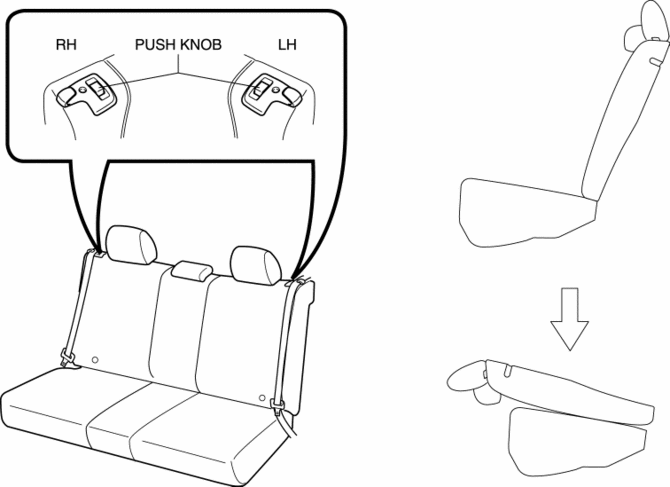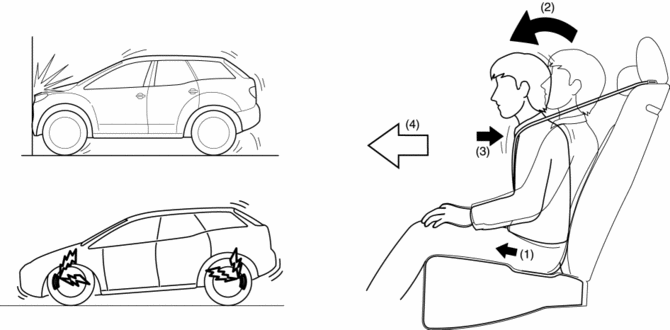Mazda CX-5 Service & Repair Manual: Rear Seat
Purpose, Function
-
The following two types of rear seats have been adopted.
-
6:4 split-type seat
-
4:2:4 split-type seat
-
The following functions have been adopted for the rear seat to protect passengers during a collision or emergency braking.
-
Prevention of passenger from slipping off rear seat cushion
-
Prevention of trunk compartment cargo from forward intrusion
-
A top tether anchor and ISO FIX anchor have been adopted to enable securing of child-restraint seats on the rear seat.
-
Full fold-down rear seat back has been adopted which enlarges occupancy space using a one-touch operation.
Construction
6:4 split-type seat
-
Hard styrofoam material is built into the front of the rear seat cushion pad.
-
The seating surface made of hard styrofoam material on the rear seat cushion is held by indenting the position which contacts the buttock of the occupant to prevent the lower body of the occupant from slipping off during a collision or emergency braking.
-
The child-restraint seat anchors include a top tether anchor and ISO FIX anchor to secure the child-restraint seats and prevent them from deviating or falling off the rear seat.

-
During a collision, a moving load is stopped by the reinforced rear seat back frame and each support point to prevent the rear seat back from collapsing forward and the luggage intruding into the cabin.

-
The easy fold-down seats can be folded down by pressing the push knobs to enlarge the cargo space.

4:2:4 split-type seat
-
By titling the front of the rear seat cushion frame upward and indenting the seating surface of the rear seat cushion, the lower body of the occupant is prevented from slipping off during a collision or emergency braking.
-
The child-restraint seat anchors include a top tether anchor and ISO FIX anchor to secure the child-restrain seats and prevent them from deviating or falling off the rear seat.

-
During a collision, a moving load is stopped by the reinforced rear seat back frame and each support point to prevent the rear seat back from collapsing forward and the luggage intruding into the cabin.

-
The easy fold-down seats can be folded down by pressing the push knobs or operating the remote handle lever to enlarge the cargo space.

Operation
-
When impact force is applied to the occupant during a collision or emergency braking, the force (1) causing the lower body of the occupant to slip is reduced by the dent in the rear seat cushion.
-
A force that causes the lower body of the occupant to slip and a force (2) that throws the upper body of the occupant occurring at the same time are suppressed (3) by the rear seat belt to prevent the occupant from being thrown (4) to the vehicle front.

Fail-safe
-
Function not equipped.
 Rear Center Seat Belt Removal/Installation
Rear Center Seat Belt Removal/Installation
CAUTION:
The ELR (emergency locking retractor) has a spring that will unwind if the
retractor cover is removed. The spring cannot be rewound by hand. If this occurs,
the ELR will not wor ...
 Rear Seat Back Frame Removal/Installation
Rear Seat Back Frame Removal/Installation
CAUTION:
When performing the procedure with a rear seat removed from the vehicle,
perform the procedure on a clean cloth so as not to damage or soil the seat.
6:4 Split Type
1. Remov ...
Other materials:
Automatic Transaxle Fluid (ATF) Inspection [Fw6 A EL, Fw6 Ax EL]
CAUTION:
If the ATF level is not within the specification or ATF is not adhering to
the dipstick after warming up the engine, do not drive the vehicle. Otherwise,
the transaxle could be damaged.
ATF level inspection
1. Remove the dipstick securing bolt.
2. Connect the M-MDS to ...
Shift Lock System [Fw6 A EL, Fw6 Ax EL]
Purpose, Function
The shift-lock system operates when the ignition is switched to ON and the
brake pedal is not depressed, and inhibits the selector lever from being shifted
from the P position to other positions.
If the shift-lock cannot be released by the normal operation, it ...
Rear Beltline Molding Removal/Installation
CAUTION:
Affix protective tape to the position shown in the figure.
1. Fully open the rear door glass.
2. Insert a tape-wrapped flathead screwdriver and then detach the clip A in the
direction of arrow (1) shown in the figure.
3. Pull up the rear belt line molding in the di ...
